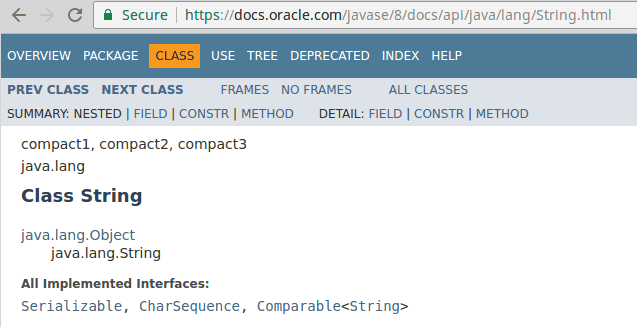Object polymorphism
We've encountered situations where reference-type variables have other types besides their own one. For example, all objects are of type Object, i.e., any given object can be represented as a Object-type variable in addition to its own type.
String text = "text";
Object textString = "another string";String text = "text";
Object textString = text;In the examples above, a string variable is represented as both a String type and an Object type. Also, a String-type variable is assigned to an Object-type variable. However, assignment in the other direction, i.e., setting an Object-type variable to a String type, will not work. This is because Object-type variables are not of type String
Object textString = "another string";
String text = textString; // WON'T WORK!What is this all about?

The API documentation for the String class begins with a generic header followed by the class' package (java.lang). After the package details, the name of the class (Class String) is followed by the inheritance hierarchy of the class.
java.lang.Objectjava.lang.String
The inheritance hierarchy lists all the classes that the given class has inherited. Inherited classes are listed in the order of inheritance, with class being inspected always at the bottom. In the inheritance hierarchy of the String class, we see that the String class inherits the Object class. In Java, each class can inherit one class at most. On the other hand, the inherited class may have inherited another class. As such, a class may indirectly inherit more than a single class.
The inheritance hierarchy can also be thought of as a list of the different types that the class implements.
Knowledge of the fact that objects can be of many different types — of type Object, for instance — makes programming simpler. If we only need methods defined in the Object class, such as toString, equals and hashCode in a method, we can simply use Object as the type of the method parameter. In that case, you can pass the method for any object as a parameter. Let's take a look at this with the printManyTimes method. The method gets an Object-type variable and the number of print operations as its parameters.
public class Printer {
public void printManyTimes(Object object, int times) {
int i = 0;
while (i < times) {
System.out.println(object.toString());
// or System.out.println(object);
i = i + 1;
}
}
}The method can be given any type of object as a parameter. Within the printManyTimes method, the object only has access to the methods defined in the Object class because the object is known in the method to be of type Object. The object may, in fact, be of another type.
Printer printer = new Printer();
String string = " o ";
List<String> words = new ArrayList<>();
words.add("polymorphism");
words.add("inheritance");
words.add("encapsulation");
words.add("abstraction");
printer.printManyTimes(string, 2);
printer.printManyTimes(words, 3);o o [polymorphism, inheritance, encapsulation, abstraction] [polymorphism, inheritance, encapsulation, abstraction] [polymorphism, inheritance, encapsulation, abstraction]
Let's continue to look at the API description of the String class. The inheritance hierarchy in the description is followed by a list of interfaces implemented by the class.
All Implemented Interfaces: Serializable, CharSequence, Comparable<String>
The String class implements the Serializable, CharSequence, and Comparable <String> interfaces. An interface is also a type. According to the class' API description, the following interfaces can be set as the type of a String object.
Serializable serializableString = "string";
CharSequence charSequenceString = "string";
Comparable<String> comparableString = "string";Since we're able to define the type of a method's parameter, we can declare methods that receive an object that implements a specific interface. When a method's parameter is an interface, any object that implements that interface can be passed to it as an argument.
We'll extend the Printer class so that it has a method for printing the characters of objects that implement the CharSequence interface. The CharSequence interface provides, among other things, methods int length() for getting a string's length and char charAt(int index), which retrieves a character from a given index.
public class Printer {
public void printManyTimes(Object object, int times) {
int i = 0;
while (i < times) {
System.out.println(object);
i = i + 1;
}
}
public void printCharacters(CharSequence charSequence) {
int i = 0;
while (i < charSequence.length()) {
System.out.println(charSequence.charAt(i));
i = i + 1;
}
}
}The printCharacters method can be passed any object that implements the CharSequence interface. These include String as well as StringBuilder, which is often more functional for building strings than String. The printCharacters method prints each character of a given object on its own line.
Printer printer = new Printer();
String string = "works";
printer.printCharacters(string);w o r k s
Remember to check your points from the ball on the bottom-right corner of the material!